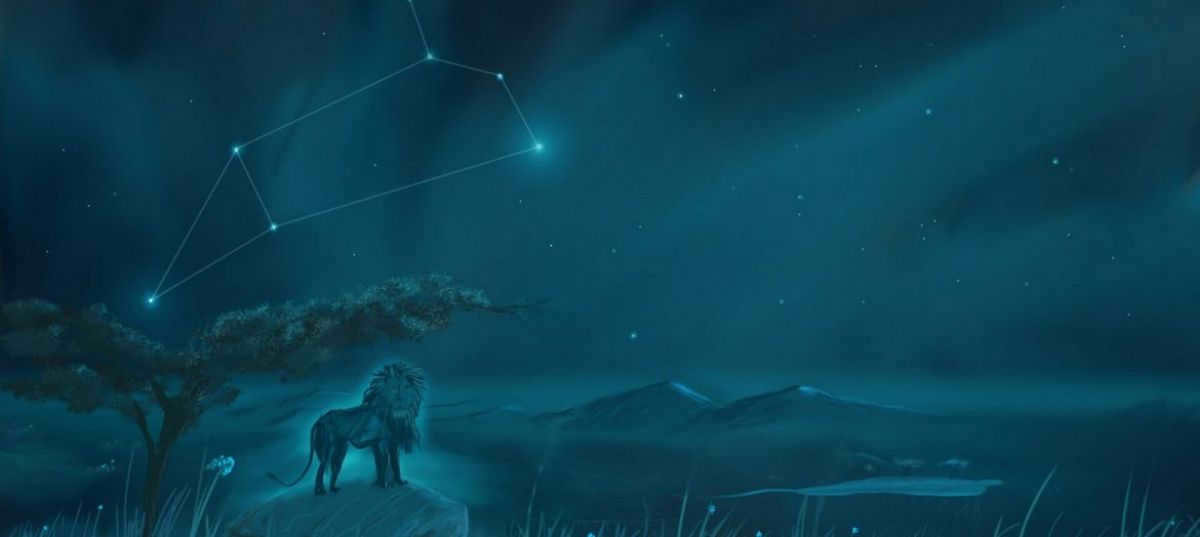
The constellation Leo is renowned for its breathtaking beauty. It is considered to be one of the most stunning zodiacal constellations in the night sky. With its expansive size, Leo covers an impressive area of 947 square degrees, making it the 12th largest constellation. This size is nearly double that of its neighboring constellation Cancer. Leo is also surrounded by other prominent constellations such as Virgo, the Big Dipper, and Hydra.
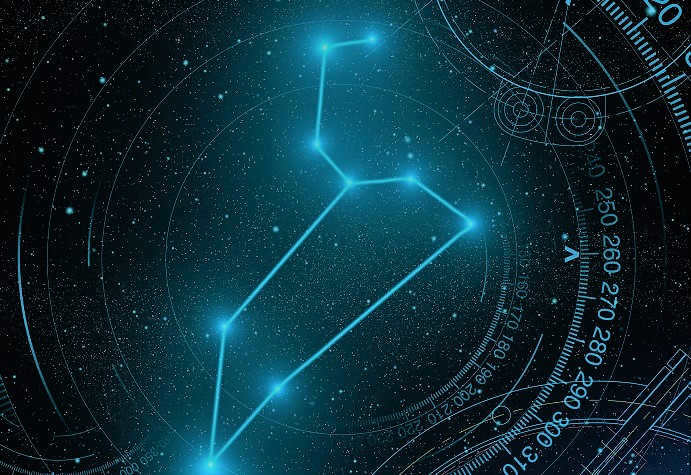
Myths and legends
Most of the myths surrounding the zodiac constellations have originated from either Ancient Greece or Ancient Egypt. And stories about the origin of Leo can be found in both cultures.
One of the most well-known tales is the story of Hercules and the Nemean Lion. The hero emerged victorious in a battle against the mighty beast and offered it as a sacrifice to honor his father Zeus. This was the first of the twelve labors of Hercules. Impressed by his son’s triumph, Zeus immortalized the Lion by transforming it into a constellation in the sky, ensuring that the hero’s deed would never be forgotten.
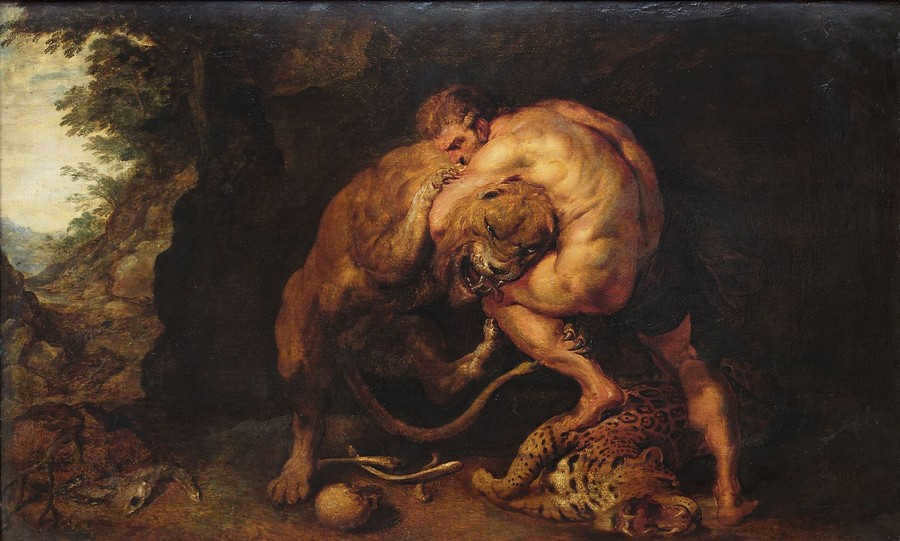
An alternative myth regarding the constellation Leo originates from ancient Egypt. The indigenous people referred to the stars as lions due to the scorching heat experienced during their peak brightness, which allowed these majestic beasts to dominate the desert.
There is also a belief that the constellation earned its name from its most prominent star, Regulus. This star’s name translates to “heart of the lion.”
Stars composing the Leo constellation
The Leo constellation comprises numerous magnificent stars and other captivating celestial objects; however, the majority of them are observable solely through a remarkably potent telescope.
As you are already aware, the most luminous star within the constellation is Regulus. Additionally, Alpha Leo is also among the most brilliant stars throughout the whole expanse of the heavens.
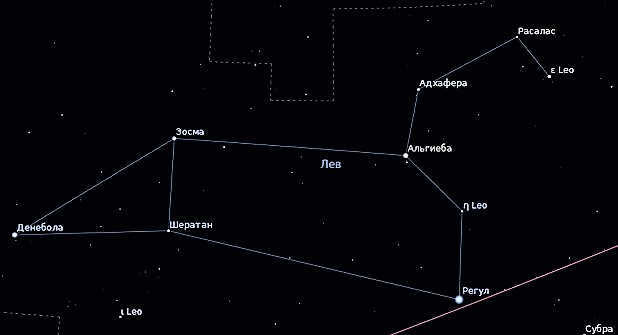
Beta Leo is the star known as Denebola, which is the second brightest star after Regulus. Its name comes from Arabic and means “tail of the lion.” It is called this because it is located in the “tail” section of the constellation.
Algieba, also known as Gamma, is a double star that is part of the asterism known as the Sickle.
The star known as delta has two names, one in Greek and the other in Arabic. It is called Zosma or Duhr, which translates to “loins” or “lion’s back.” It is a multiple star system with one companion, and it is possible that it has another companion as well.
Adhafera – Zeta. This is a binary star that forms part of the Sickle asterism. There has been some confusion regarding its name, as in certain works Adhafera is referred to as both a star and a luminary from the neighboring constellation of Veronica’s Hair. It was only in 2016 that the International Astronomical Union officially assigned the name Dzeta Leo to this star, putting an end to the uncertainty.
Theta Leo is a white subgiant in the constellation. It is known by three different names, all of which refer to the thigh or rib of a lion. The Arabs refer to it as Hort and Chertan, while its Latin name is Coxa or Coxa.
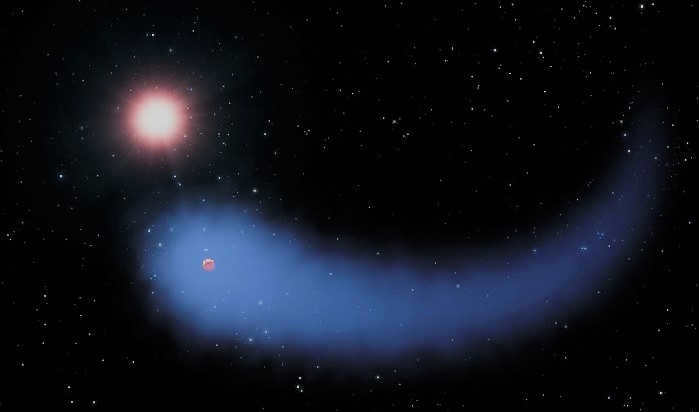
The designation Mu corresponds to Rasalas, signifying “lion’s head.” It represents an orange giant star with a celestial body in its orbit, which is roughly 2.5 times the size of Jupiter.
Ro is another captivating star known as Shire, a blue supergiant with a mass exceeding 20 times that of the sun. Rho is a variable star that displays pronounced pulsations, making it highly probable to undergo a supernova event within a few million years.
Additional items
The Leo constellation houses numerous spiral and elliptical galaxies, contributing to its captivating appearance. Another factor enhancing its beauty is the Lion’s Ring, a vast cloud of hydrogen and helium.
Adjacent to the star Adhafera in the lion’s tail lies another constellation known as the Hair of Veronica. Initially, it was regarded as a mere cluster within the Leo constellation and was referred to as a “tassel” due to its location at the tail’s extremity.
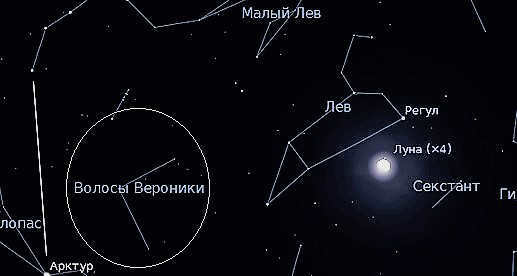

The group of stars known as the Sickle, found within the constellation Leo, is a prominent feature that cannot be overlooked. Its name is derived from its distinct shape, which closely resembles that of a sickle or a mirrored question mark.
The constellation Leo can be observed in Russia throughout the year, except for the period between August 10 and September 15, when it is blocked by the Sun. The best months for observing Leo are February and March. The lion can be seen in latitudes ranging from +84 to -56 degrees.
A vibrant still life featuring a book captures my love for this genre. The subjects, perspectives, and colors all contribute to its appeal.
Ivan Slavinsky is a renowned artist from Saint Petersburg.
These are my personal photos from Mettmann on May 3, 2019.
Experience the best Jewish anecdotes! One such anecdote involves a Jewish lawyer’s son who followed in his father’s footsteps and became a lawyer as well.
Discover the fascinating “Mayevki” celebrations of Peter the Great and the wild parties held by Dostoevsky in the Ekaterinhof Park.
–Tags
–References
–Search by diary
–Subscribe by e-mail
–Friends
–Statistics
The Leo constellation in the realms of astronomy, astrology, and legends
From the 23rd of July to the 22nd of August, Leo takes charge of the zodiacal sky. The Lion is undeniably a regal creature, symbolizing strength and dominance, and tolerates no rivals.

The Lesser Lion was initially observed and documented by Jan Hevelius in 1610. He included this particular constellation in his comprehensive atlas Uranographia.
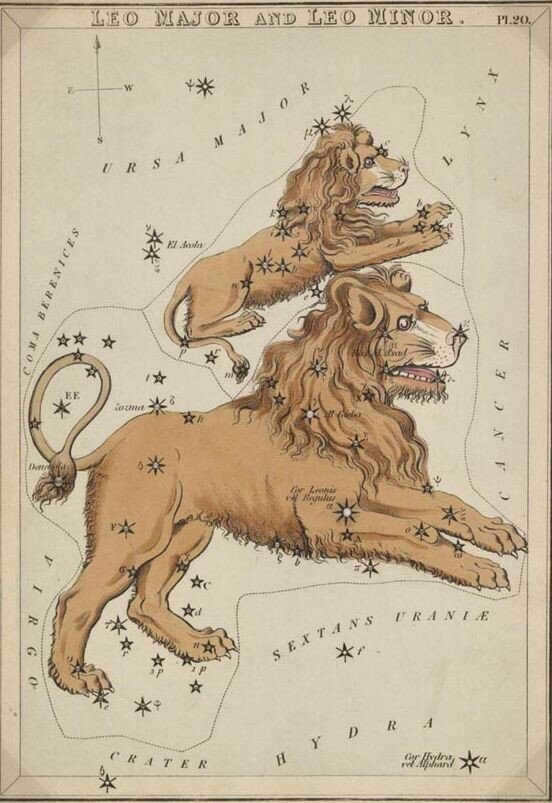
A representation of the constellation Leo found in Jan Hevelius’ celestial atlas.
It is more commonly referred to as Big Leo. And there’s a good reason for that. Big Leo has a lot more to boast about. Its most luminous star, Regulus (derived from the Latin word for “king”), shines 160 times brighter than our Sun and is roughly three times larger in size. It is also occasionally known as the “Heart of the Lion” (Cor Leonis).
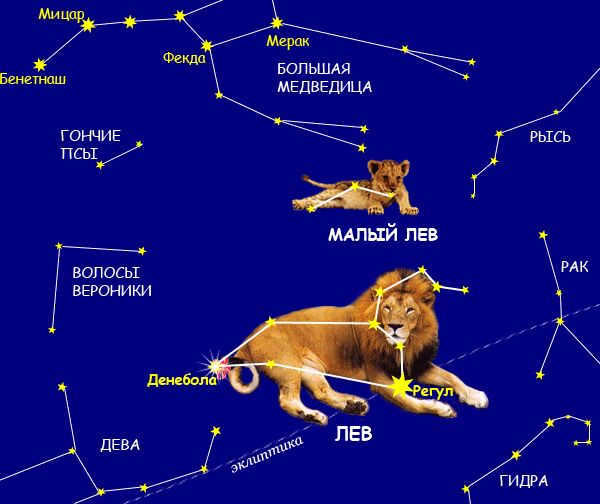
Located at the foot of the Lion’s Head is the most luminous celestial body, known as Algieb (γ Leo), which is interpreted as “the mane of the lion”. In the month of January 2001, astronomers made an astounding breakthrough by detecting a colossal entity, measuring eight times the magnitude of Jupiter, revolving around Algieba.
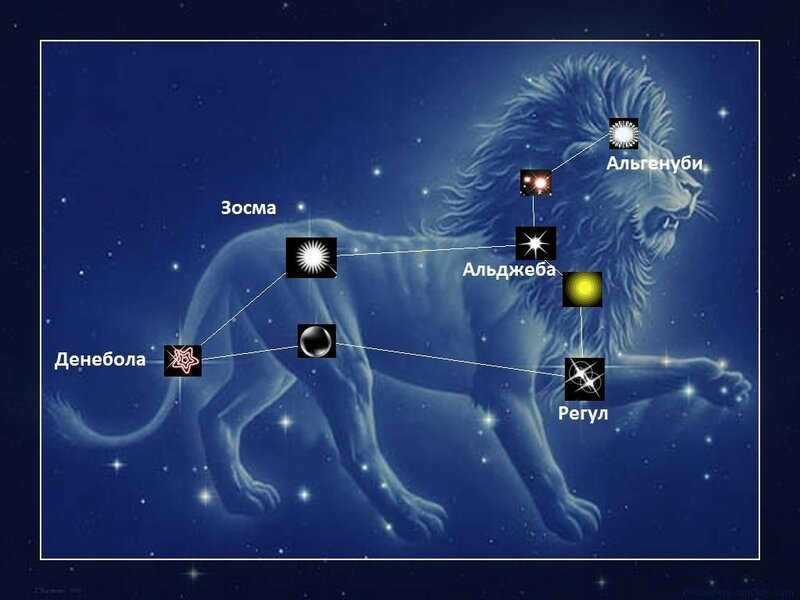
The configuration of the brilliant celestial bodies bears a resemblance to a reclining lion, with its head and chest forming the renowned Sickle asterism, which bears a striking resemblance to an inverted question mark.
The trio of celestial bodies positioned at the rear of the lion’s figure commences with the star Denebola (β Lion), which translates to “tail of the lion”. In total, there are approximately 70 celestial bodies, although the majority of them are only faintly discernible.
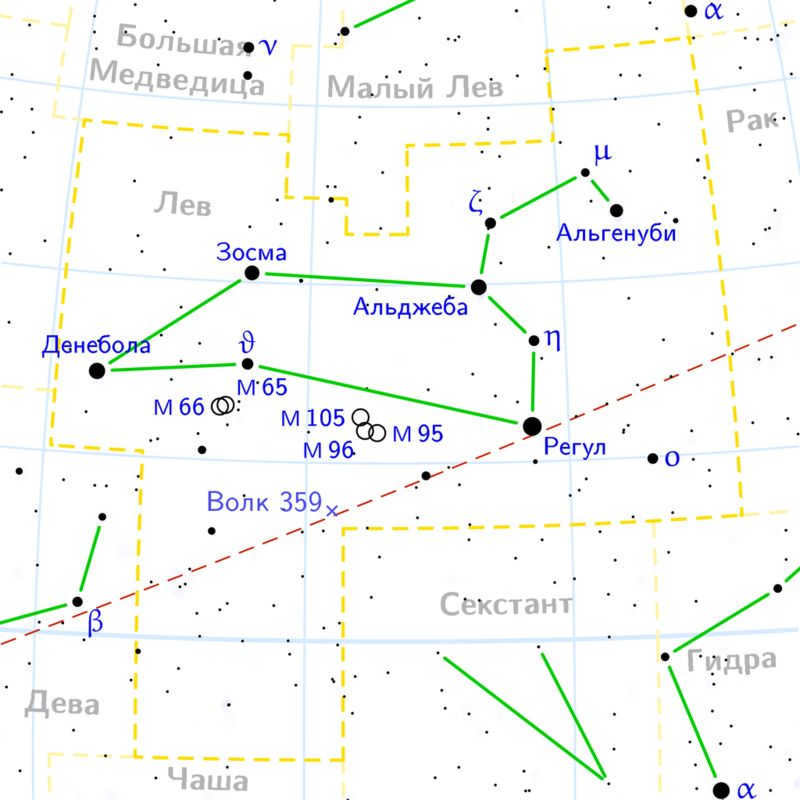
Leo consists of several bright galaxies, such as M66, M65, and NGC 3628, which are known as the Lion Triplets. Additionally, there is a celestial structure called the Lion’s Ring, which is composed of hydrogen and helium and is believed to have originated from two smaller galaxies. Furthermore, the Leonids meteor shower occurs in mid-November, peaking on November 17.
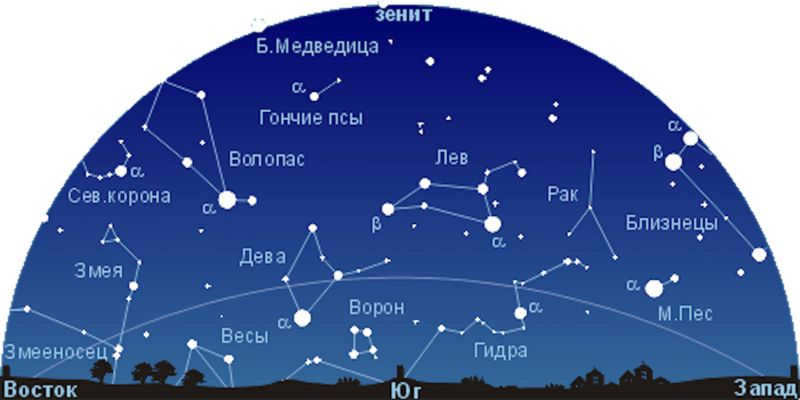
Leo is one of the constellations that humans have recognized for a long time. The people of Mesopotamia have documented this constellation under the name “Lion”. It was called “Ser” or “Shir” by the Persians; “Artan” by the Turks; “Aguo” by the Syrians; “Ague” by the Jewish nation; and “Simha” by the Indians. All of these names mean “Lion”.

Lysippus, the renowned Greek sculptor of the early Hellenistic period (4th century BC)
The constellation Leo represents the Nemean Lion, which was slain by Hercules during his first of twelve labors. This act of vengeance was carried out in response to the lion’s murder of Hercules’ family. According to Greek mythology, the lion resided in a mountain valley near the city of Nemea in Argolis, terrorizing the region and slaying its inhabitants. The lion possessed extraordinary size and strength, and its skin was so impervious that neither iron, bronze, nor stone could penetrate it.
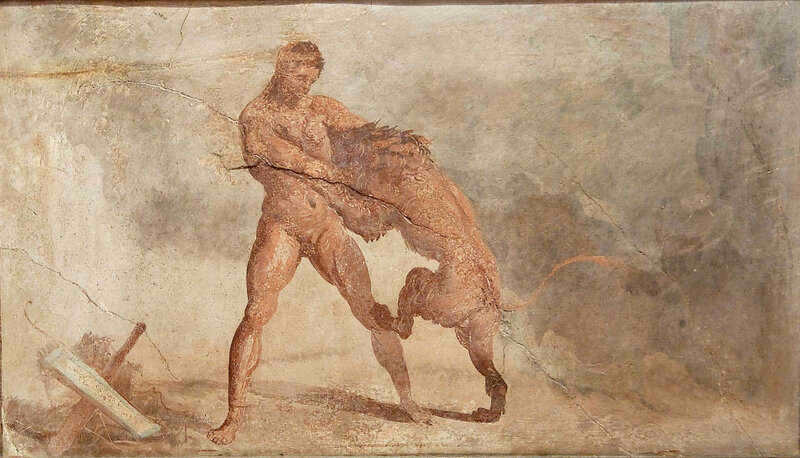
There is a fresco in Pompeii which shows a scene of Heracles battling the Nemean lion.
While traveling to Nemea, Heracles made a stop at the farm of Molorchus. They made a pact that if Heracles did not return within 30 days, Molorchus would offer his last ram as a sacrifice to the rulers of Hades. However, if Heracles did return on time, the ram would instead be sacrificed to Zeus. Remarkably, it only took Heracles 30 days to locate the cave where the Nemean lion resided. He cleverly blocked one of the cave entrances with stones and positioned himself near the other entrance, patiently awaiting the appearance of the formidable beast. As the sun began to set, Heracles spotted the lion and skillfully launched three arrows in quick succession, but unfortunately, none of them managed to penetrate the lion’s impenetrable skin. In a bold move, the lion pounced on Heracles, but he swiftly retaliated by striking the beast with a sturdy stick crafted from an ash tree that had been felled in the Nemean grove. This blow left the lion stunned, giving Heracles the opportunity to overpower and strangle the mighty creature. Heracles proudly brought the lion to Heaven as one of his triumphant conquests.
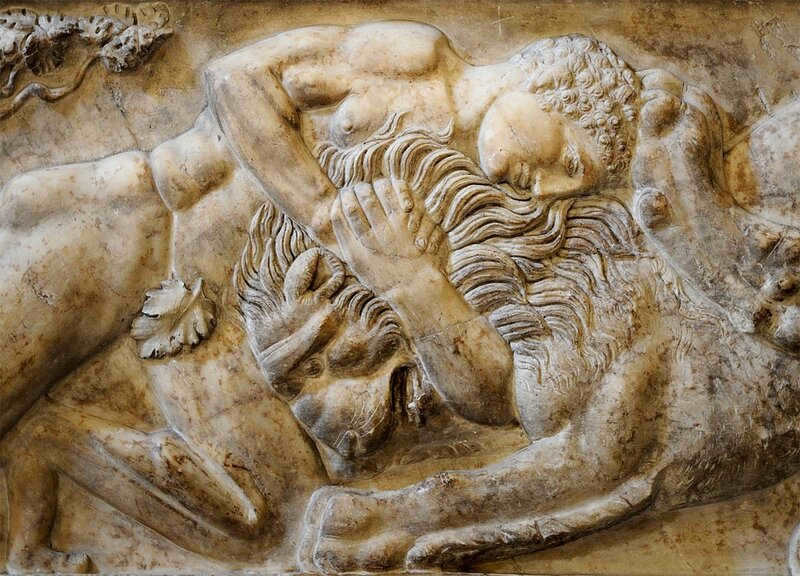
The relief on the frontal wall of the marble sarcophagus
Many centuries ago, approximately 4,500 years ago, the constellation Leo marked the point of the summer solstice. In hot southern countries, this time of year was dominated by intense heat, leading many cultures to associate the Lion with fire. The Assyrians referred to it as the “Great Fire”.
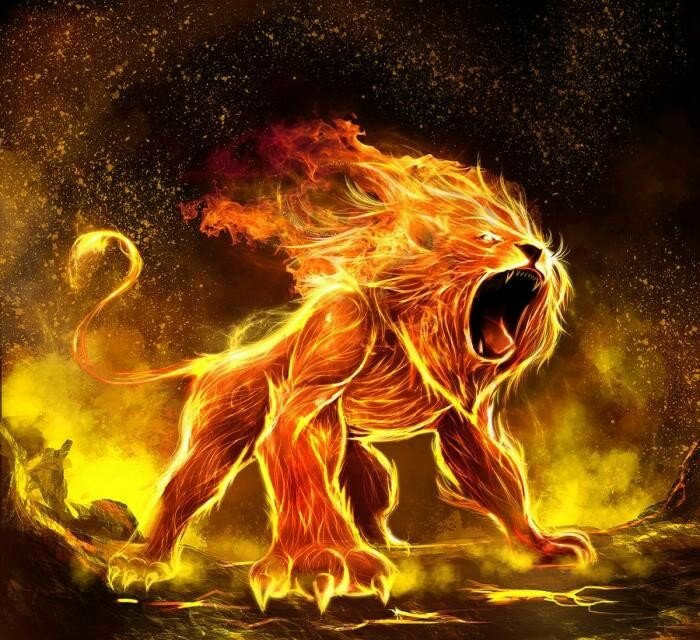
In ancient Egypt, during the summer solstice, the Nile River would start to flood. To control the water flow and direct it to the fields, the Egyptians constructed gates in the shape of a lion’s head. This tradition is still visible today in the form of fountains where water flows out of a lion’s mouth. The origin of this tradition is often overlooked, but it dates back to the ancient times when the flooding of the Nile was a significant event for agricultural purposes.
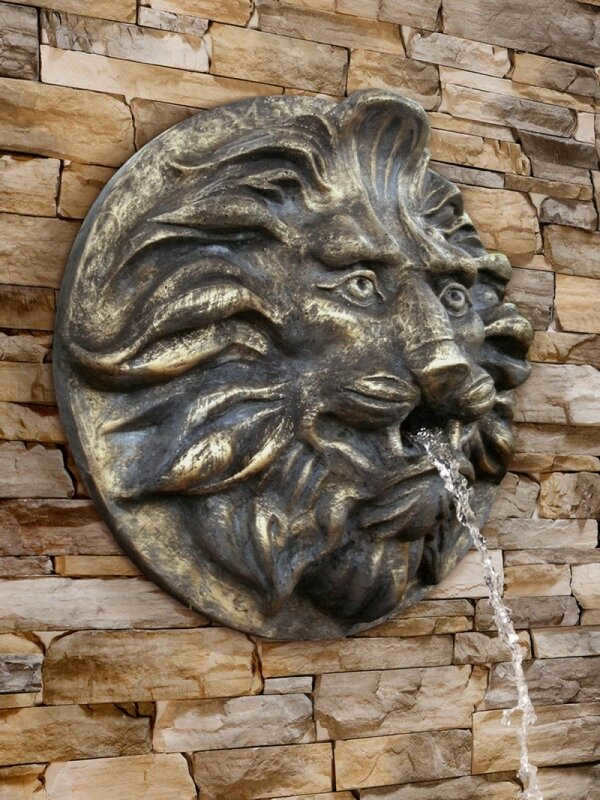
Astrology is not a scientific discipline, yet it assigns Leo as the fifth celestial constellation in the Zodiac, representing the sector of the ecliptic ranging from 120° to 150° when measured from the vernal equinox.
According to Western astrology, the Sun is said to be in the zodiac sign of Leo starting from around July 23 until August 21. It is important to note that the zodiac sign of Leo should not be mistaken for the actual Leo constellation, as the Sun resides in the zodiac sign of Leo from August 10 to September 15.
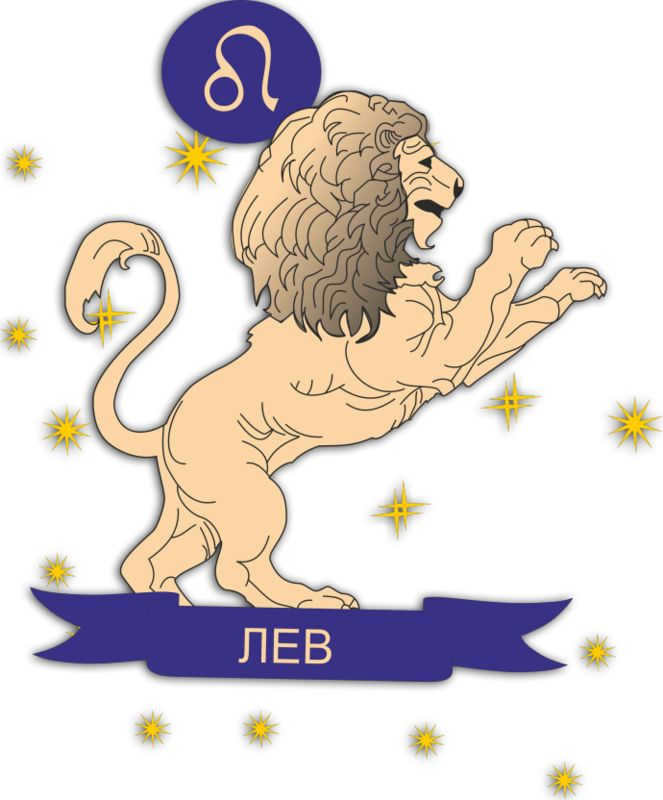
The fortunate color for Leo is gold, orange, white, and red.
The flowers associated with the Leo zodiac sign are sunflowers.

Leo is characterized as a masculine astrological sign with an outgoing personality. Each Leo individual is believed to be born with inherent luck, which helps them overcome any challenges they face in life.
There are two distinct groups of Lions. The first group values status more than money, while the second group prioritizes money over status. However, if a Lion follows their heart, they can overcome any obstacles they encounter.
Like all natural-born leaders, Lions are constantly driven to create something new, both in the spiritual and material realms. In order to achieve their goals, Leos are willing to invest significant amounts of money, time, and knowledge, often neglecting their own needs in the process.
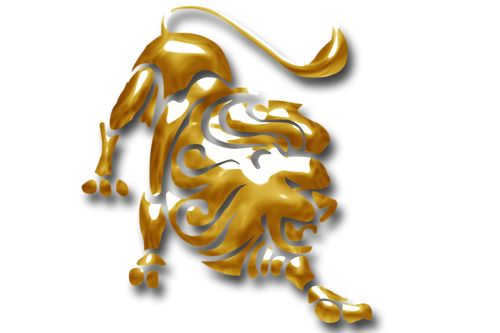
Lions have a strong attraction to the opposite sex, but their excessive gullibility often leads to their downfall. Leos can easily become victims of deception because they trust others as much as they trust themselves.
Lions do not tolerate dishonesty. If they discover that their partner has been unfaithful, the betrayed Lion will likely give up on love altogether. Lions despise being lied to outright. If a person born under this sign learns that you have lied to them, you can expect them to cut ties with you permanently. In this scenario, you will never regain the Lion’s respect.
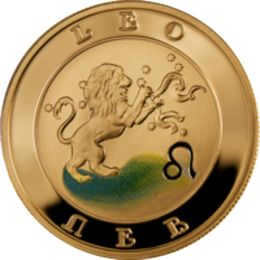
The constellation Leo is named after the lion. Lions are known for their fearless nature and their willingness to protect their friends and loved ones. Their bravery is unmatched, as they fearlessly confront their enemies, tearing them apart. Lions possess an innate strength and courage that is not fully understood, even by themselves. It is as if something inside them ignites during such moments, making them even more powerful and fearless.
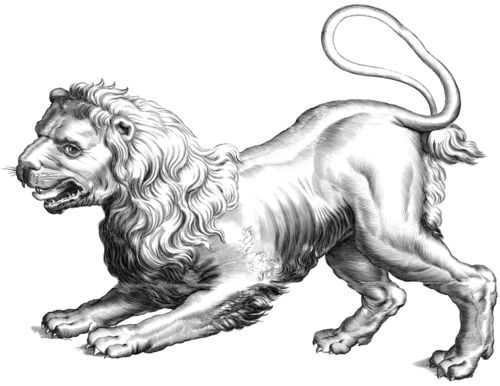
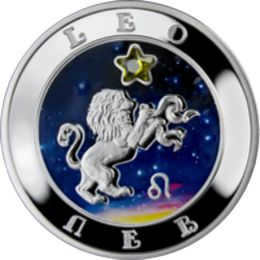
Lions have a strong affinity for opulence that highlights their social status, although it may not be evident in every aspect of their lives. There are certain things that hold immense importance to them and they will never compromise on them. Some Lions enjoy dining at upscale restaurants, others prefer driving luxury cars, and some have a penchant for fashionable clothing. They are willing to make sacrifices in order to indulge in these desires.
When it comes to self-perception, Lions always hold themselves in high regard. Their pride is their weakness, as they can easily be won over with flattery, making it the simplest way to their hearts. However, even the slightest criticism can cause them to shut down and hinder any chance of peaceful coexistence.
These are the characteristics that define Lions.
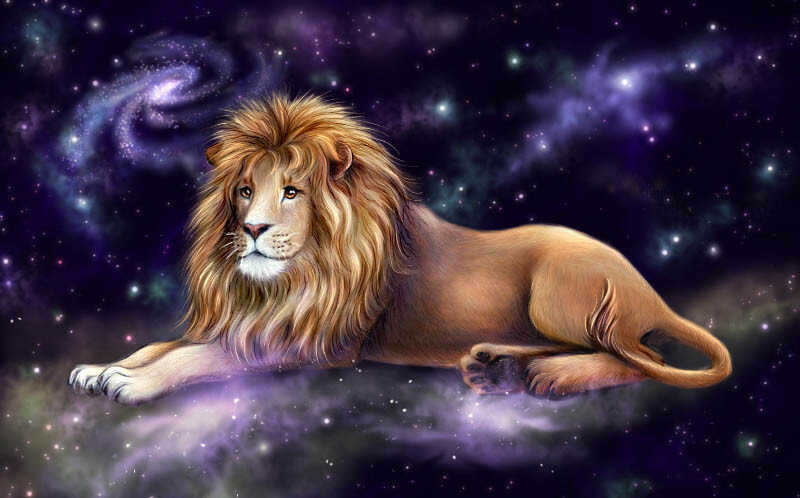
Individuals born under the sign of Leo go through three stages of soul development. The highest level is symbolized by the Sphinx – a mythical creature known for its wisdom and guidance. The second level is represented by the Lion, the king of the jungle, who balances the Lion’s ego and always defends and supports their loved ones. The final level is the Lion cub, representing immaturity and fear of the unknown.
Although Lions can sometimes exhibit laziness, selfishness, and inconsideration, they are also incredibly beautiful, artistic, and pleasant individuals.

Big congrats to all the Lions, Lionesses, and Lions who were born during these beautiful summer days!
May the symbol of the “Sun” always shine brightly on your journey through life!

The Leo constellation is situated in the sky between Cancer and Virgo. It is one of the twelve constellations that form the zodiac, which includes Aries, Taurus, Gemini, Leo, Cancer, Virgo, Libra, Scorpio, Capricorn, Sagittarius, Aquarius, and Pisces. All of these constellations follow the ecliptic, which is an imaginary line that the sun follows throughout the year.
If you observe the sky, you will find Leo positioned 9° east of Cancer and 12° northeast of the Hydra constellation.
Constellations are often connected to various stories and legends, and Leo is no exception.
Interestingly, Leo is one of the oldest constellations known to mankind. Ancient civilizations, including the Babylonians and Egyptians, associated it with the sun. Throughout history, Leo has always been recognized as one of the zodiac signs.
Origins of the Constellation
Around four thousand years ago, the Babylonians were the first to document the position of the brightest star in Leo, known as Regulus.
Later on, Hipparchus also observed Regulus, along with the star Spica, in his quest to understand the movement of the equinoxes, which is now known as the precession of the equinoxes.
Regulus was given its name by Copernicus, which translates to “little king”. It was also referred to by other names such as king, strong, and hero.
In Persian mythology, Regulus was considered one of the four guardian stars, alongside Fomalgaut, Aldebaran, and Antares.
In the mythological tale, Heracles slew a lion named Leo, which is represented by the constellation. Interestingly, the neighboring constellations of the Lesser Lion and Sextans do not have any known mythological connections.
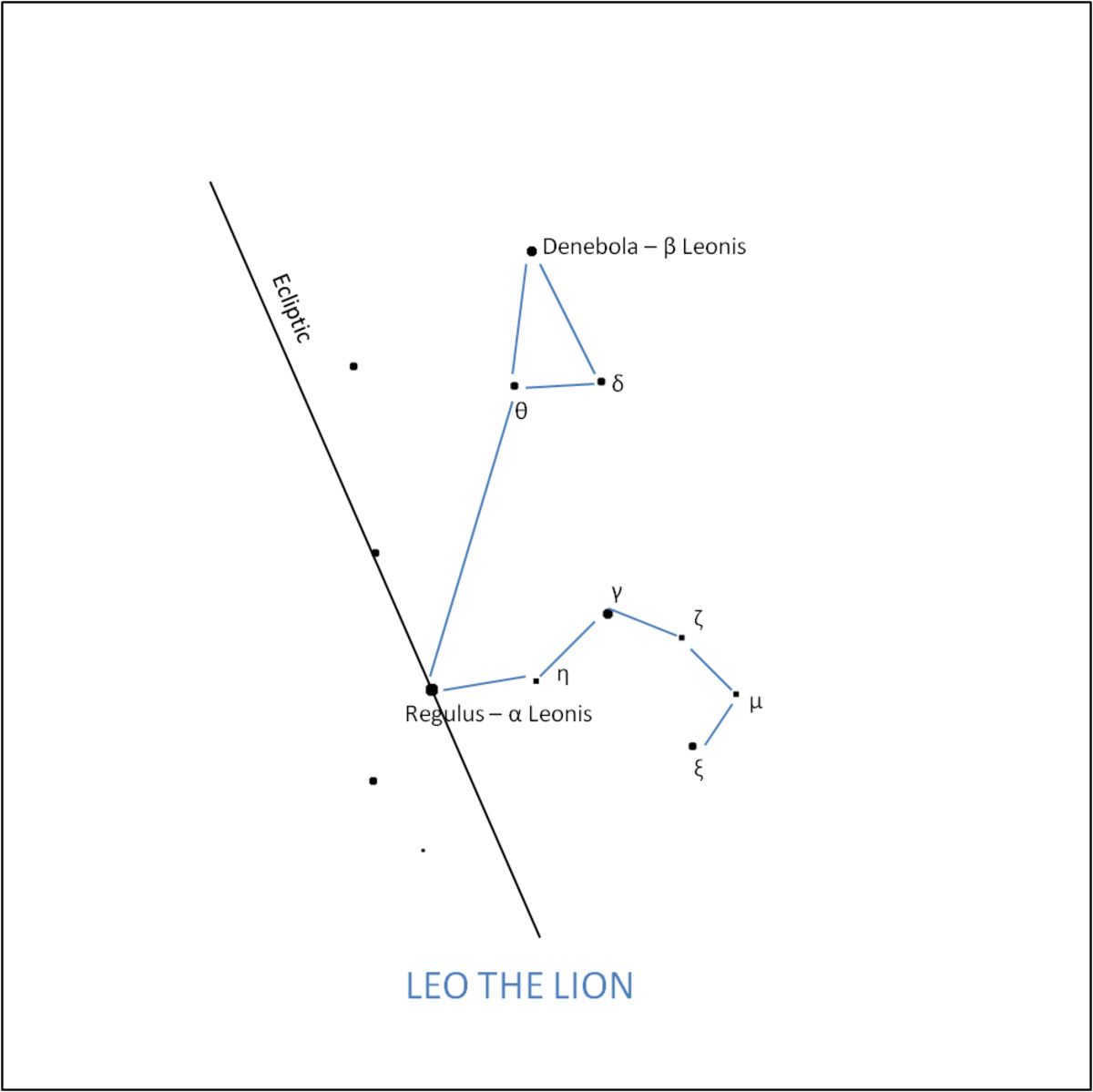
Here is my representation of the Leo constellation.
© C. Calhoun 2012. All rights reserved.
Leo in the celestial sphere
Upon observing this constellation, one will immediately notice its distinctive pattern resembling a reversed question mark, known as a sickle. This arrangement of stars constitutes the head of Leo. Regulus, situated at the bottom, is accompanied by five other prominent stars – Leonis, Algeiba, Aldhafera, Rasalas, and Asad Australis – forming the remainder of the sickle. Except for η Leonis, these stars are referred to by their Latin names. Please refer to the table below for the Greek names more commonly employed in the scientific community.
Leo is positioned in close proximity to the Big Dipper constellation, lying south of it in the night sky.
The Leo constellation is characterized by the body of Leo protruding from the sickle, with the star Denebola forming the back, and the stars Zosma and Chort forming a triangle.
Notable Stars in the Leo Constellation
Regulus
Regulus is positioned at the lower part of the sickle and holds particular interest due to its location on the ecliptic. This means that once a year, on August 23rd, the Sun eclipses Regulus.
Located approximately 71 light-years away, Regulus is continuously moving farther away at a rate of 1.5 miles per second. It shines with a brightness that is about 130 times greater than the Sun, appearing as a white to blue-white star. With a magnitude of 1.3, Regulus is considered relatively bright. However, it is only the 19th brightest star out of the 20 brightest stars in the sky.
Regulus also possesses a companion star, although it is significantly fainter, with a brightness level of 8th sidereal magnitude.
Denebola
The star Denebola, constituting the rear of Leo, is highly prominent and forms the tail. It is nearly as bright as Regulus, although not quite. Its magnitude is 2. In ancient times, its magnitude was estimated to be within the range of “1”, but its brightness has remained relatively unchanged over the course of millennia.
When observing the night sky, Denebola is located 25° east of Regulus. It is 16 times more luminous than the Sun, situated 39 light years away from us, and is receding from us at a speed of 1 mile per second.
Denebola is also known as β Leonis. Along with δ Leonis and θ Leonis, they form a triangular shape on the rear of Leo, as mentioned previously.
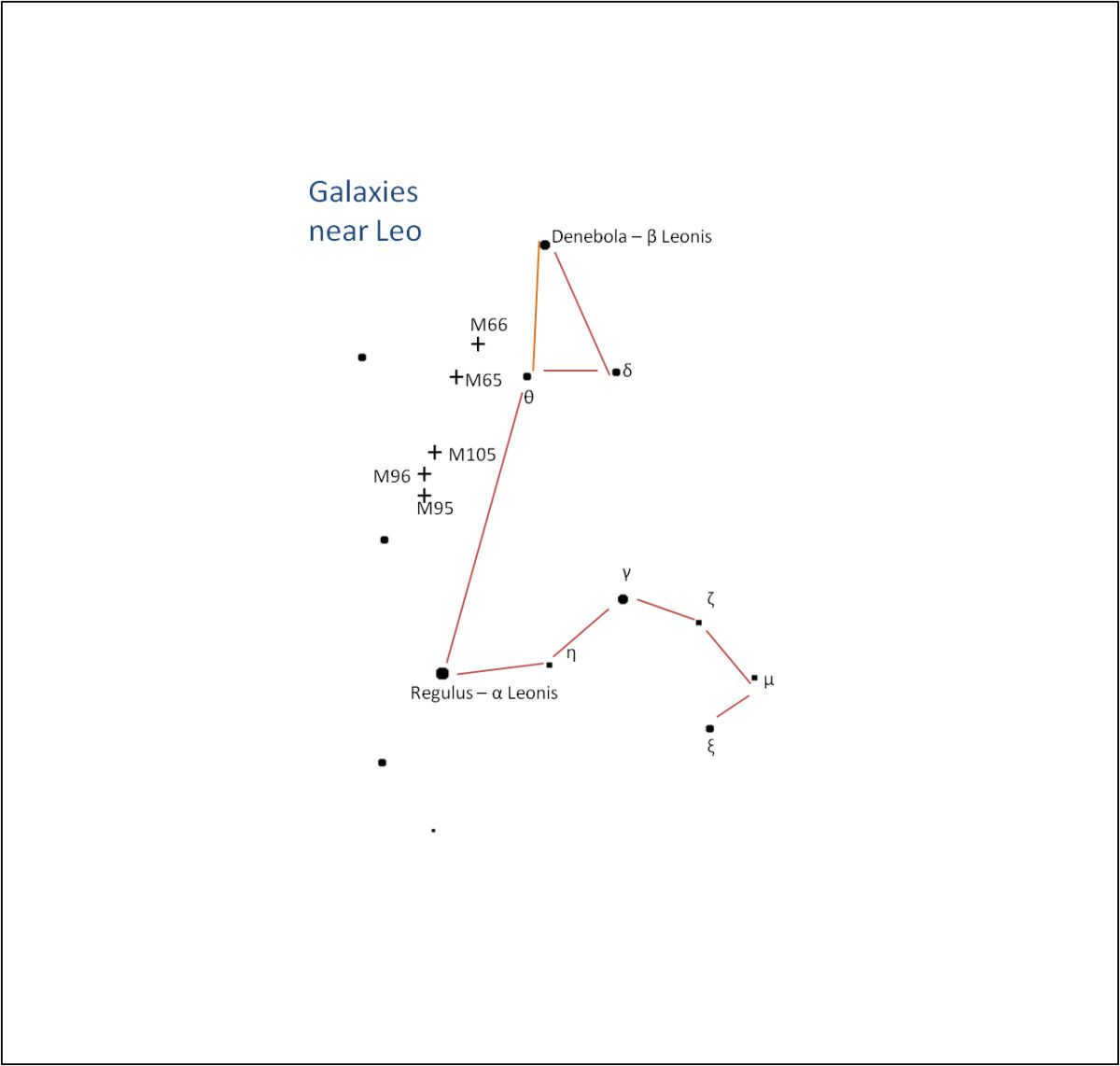
Here is my personal depiction of Leo and the neighboring galaxies.
C. Calhoun 2012. All rights reserved.
The Constellation of Leo
λ Leonis is a binary star situated to the southwest of the sickle. It is currently moving towards us at a velocity of 24 miles per second.
This binary star system is visually appealing, especially under moonlight or just before nightfall. The two stars display vibrant yellow-orange and green hues. The yellow-orange star shines brighter than its companion, with respective magnitudes of 2.2 and 3.5.
Although these binary stars are not easily visible to the naked eye, a small telescope should suffice for observation. Their orbital period is rather lengthy, taking nearly 100 years to complete a full revolution.
R. Leonis is an intriguing star that can be found southwest of Regulus, slightly below the ecliptic. This particular star is classified as a variable star, meaning its brightness fluctuates over time. It goes from being a relatively bright star with a magnitude of 5 to a rather dim one with a magnitude of 11, and this cycle repeats every 313 days. When R Leonis is at its brightest, it emits a red hue and can be seen without the aid of a telescope.
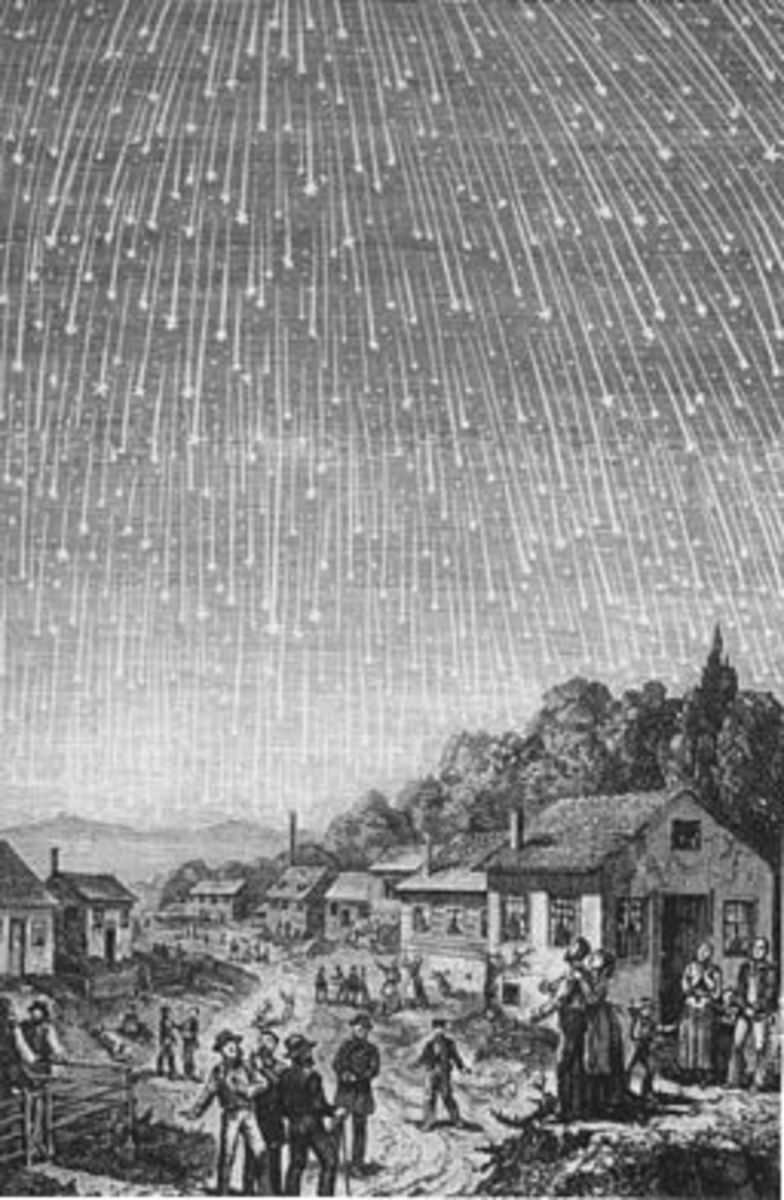
One of the most well-known depictions of the Leonid meteor shower, this engraving from 1889 is in the public domain.
Image credit: Adolf Vollmi, via Wikimedia Commons
Galaxies and the Path of the Leonid Meteor Shower
Located to the west of Leo’s main body are five galaxies, with M65 and M66 being the most prominent. These galaxies are situated about 29 million light years away from us, making them invisible to the naked eye, although they can be faintly seen with binoculars.
Every November, the Leonids meteor shower can be observed. The meteors originate from Leo’s head and occur around November 14th or 15th.
Overall, Leo is an intriguing constellation with a rich history and numerous fascinating celestial objects to explore.
References
Field Book of the Heavens. Olcott, William. Van Rees Press: New York. 1974.
A guide to the stars and planets. Moore, Sir Patrick. Firefly Books: New York. 2005.
Seasonal star charts. Hubbard Scientific Company, 1972.
Handy Space Answer Book. Dupuis, Diane and Phyllis Engelbert. Visible Ink Press: Canton, Michigan. 1998.
© 2012 Cynthia Calhoun
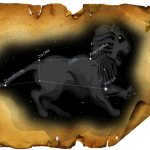
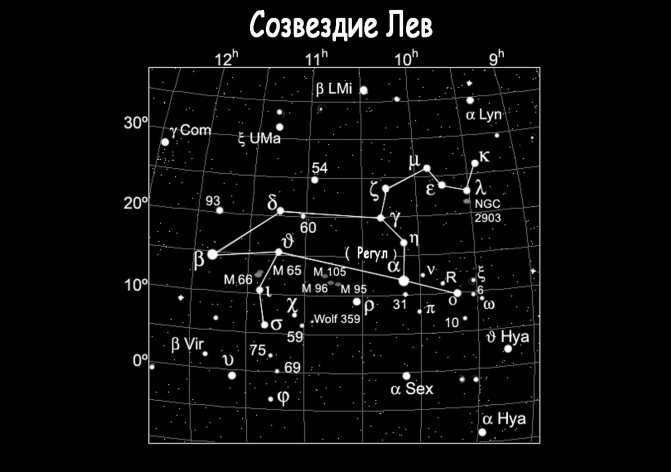
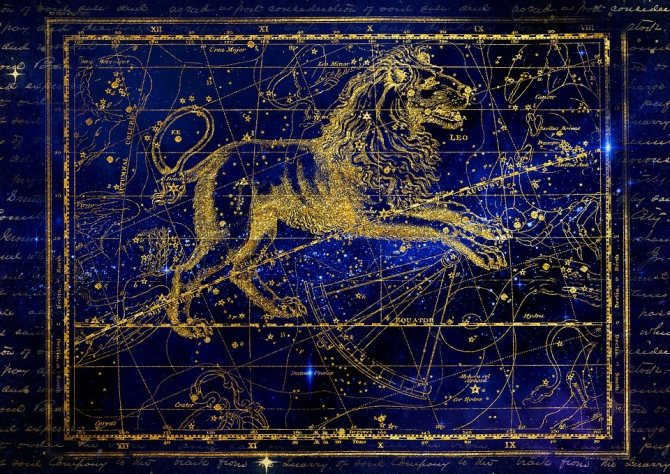
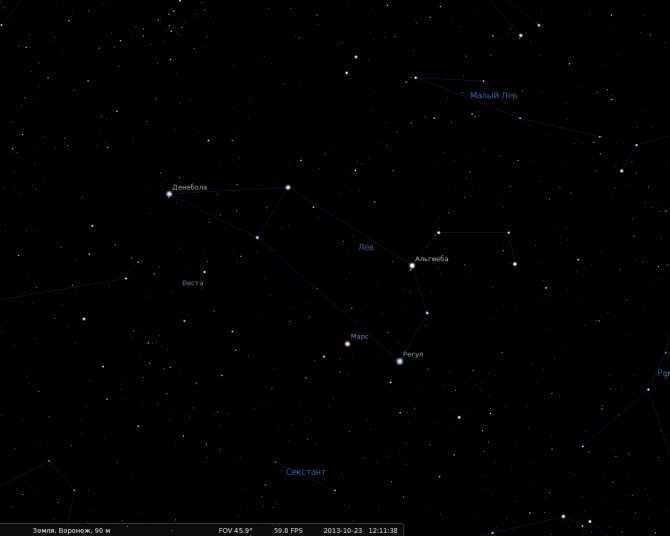
The lion is known for being one of the most prominent members of the zodiac constellations, and it lies along the ecliptic, which is the path that the Sun travels in space. Positioned between Cancer and Virgo in the night sky, Leo is accompanied by nearby constellations such as Sextant, the Big Dipper, the Little Lion, and the Bowl. Upon close observation, the arrangement of the brightest stars in Leo indeed resembles a reclining animal. According to legend, this constellation is said to have been inspired by the Nemean lion, which was famously vanquished by Heracles.
The most luminous celestial body in the Leo constellation is Regulus. In addition, it stands out as one of the most brilliant stars in the entire nocturnal expanse due to its proximity to Earth. Regulus may be challenging to observe as it lies on the ecliptic and can be obscured by the presence of the Moon, Venus, and Mercury. Notably, the primary star shines with an intensity 160 times greater than that of the Sun. The Arabs referred to Regulus as the “Heart of the Lion,” while its name in Latin conveys the meaning of a “little king.”
Moreover, the constellation is comprised of various fascinating stars. To illustrate, situated at the posterior of the “beast of prey” lies the star Denebola – which directly translates to “tail of the lion”. This particular star ranks as the third most luminous celestial body within the constellation and possesses a mass that is twice that of the Sun. Conversely, positioned at the opposite extremity is the Lion’s Mane, the radiant golden star known as Algieba, which exists at a considerable distance from Earth. Additionally, tucked away within the wildcat’s thick mane is the zeta of Leo, otherwise identified as Adhafera. This star is truly an astronomical giant, emitting tremendous power and brightness – surpassing the Sun in size by several tens. Zeta is situated at a distance exceeding 270 light-years from our planet.
In addition to its “predatory” luminaries, the constellation Leo conceals one of the nearest stars to Earth. This star is known as the Wolf or Wolf, and it is a red dwarf that exhibits intermittent flares. Within a matter of minutes, the Wolf can flare up and then abruptly extinguish, remaining dormant indefinitely. This young and intriguing star has yet to reach its full brightness.
Of particular interest to both experts and amateurs is the Kaffau star, which was recently discovered within the galactic halo. This stellar entity is not only powerful, but also one of the oldest stars within the Milky Way. With minimal amounts of oxygen and carbon, Caffau remains a perplexing enigma within the scientific community, captivating the minds of countless researchers.
How to spot the constellation Leo in the night sky?
Category: Sky Gazing Posted on 03/22/2018 – Comments: 0 – Estimated Reading Time: 4 min – Views: Post Views: 19,254
Many constellations differ greatly from their namesake. For instance, the constellation Pegasus doesn’t closely resemble the legendary winged horse, and the constellation Lynx doesn’t resemble the forest predator.
However, Leo is a different story. With just a touch of imagination, it’s easy to locate and identify the king of the animal kingdom in the arrangement of its brightest stars. The shape of this constellation is so uncomplicated and meaningful that it becomes ingrained in memory almost immediately. As a result, Leo is frequently used as a guide for locating neighboring constellations, which lack the same level of clarity.
So, how can we locate the constellation Leo in the vast expanse of the starry sky?
First, let’s establish a time frame for our search. We should focus on the evening, as it is more convenient than searching at night or early morning (during the night, we are usually asleep, and in the morning, we are busy with studying or work).
In the evenings, we can observe the Leo constellation starting from February. During this period, Leo can be seen rising in the east just after dusk and can be observed in the southeast later in the evening.
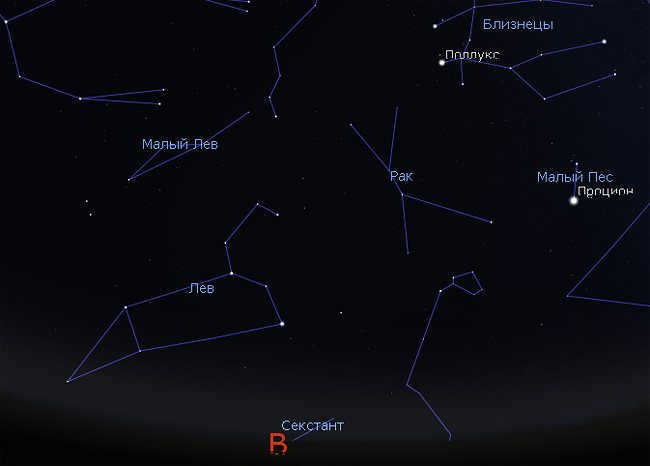

In the evenings of February, you can spot the Leo constellation rising late in the eastern sky. Image: Stellarium
One distinctive feature that sets Leo apart from other constellations is the presence of a large trapezoid formed by four stars. This trapezoid is nearly the same size as the Big Dipper, and the brightness of the stars in both these celestial formations is quite similar. The brightest star within the Lion’s Trapezoid can be found in its lower right corner. This star is called Regulus, which is not only the primary star of the constellation but also the twentieth brightest star in the night sky.
The constellation Leo can be best observed during the spring season, particularly in the first half of spring. During the month of March, Leo can be seen in the southeast region of the evening sky, positioned halfway between the horizon and the zenith. This makes it a convenient time to spot Leo, as it appears quite high in the sky during dusk.
As we move into April, Leo becomes even more prominent in the evening sky. It now shifts to the south and dominates the spring sky, as the surrounding constellations are relatively faint. In fact, only two stars, Arcturus and Spica, shine brighter than Regulus in the spring sky. However, the constellations associated with these stars, Capricorn and Virgo respectively, are also relatively dim. In April, the trapezium shape of Leo can be easily spotted in a horizontal position, making it even easier to locate in the night sky.
Also, check out: “Myths and Legends of Constellations” by Bonov Angel Damyanov – RuLit – Page 46
Moreover, if you are still unsure about your ability to spot the Leo constellation in the sky on your own, here’s a helpful tip: Leo can be found just below the handle of the Big Dipper! Remember this, and you’ll be able to locate Leo quickly at any time of day or year, as long as it is above the horizon at that particular moment.
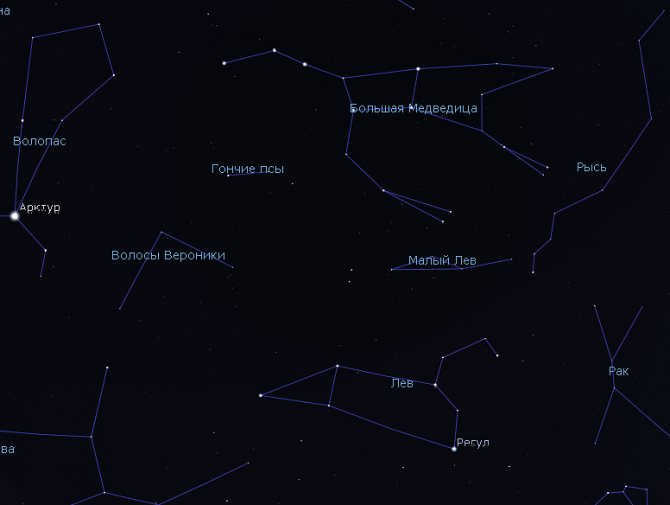
During the spring season, the Big Dipper reaches its highest point in the sky, while the Leo constellation can be seen below it in the southern part. Image: Stellarium
In the month of May, darkness falls later in the evening, allowing the Leo constellation to be visible in the southwest sky for only a few hours before it sets below the horizon.
Now, you might be wondering: why was the Leo constellation named after the king of animals instead of just Trapezium?
When you come across the constellation Leo in the heavens, make sure to give it a thorough examination. Just above the right side of the trapezoid, you will likely spot three additional stars that, when combined with Regulus and the star Algieb (the upper right star in the trapezoid), create a shape resembling a question mark facing in the opposite direction. This formation has been known for centuries as the Sickle, named after an old farming instrument due to its striking resemblance.
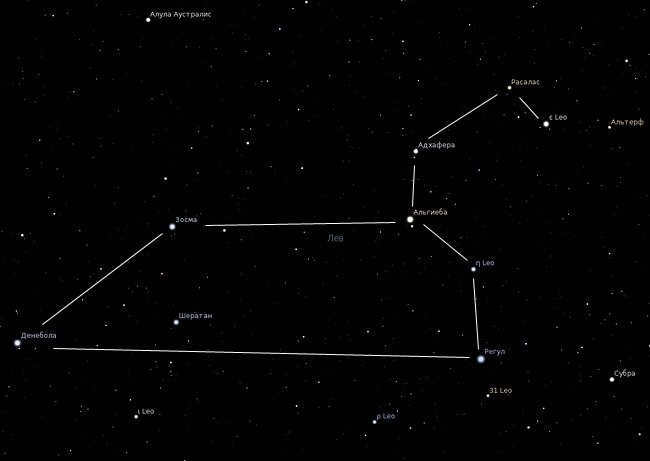
The asterism known as the Sickle of the Lion is displayed here. The sickle’s handle is indicated by the star Regulus, while the stars Algieb, Adhafera, Rasalas, and the epsilon of Leo form the sickle itself. Ancient maps often depicted the forelegs, chest, and head of a reclining predator in this area. Figure: Stellarium
In this depiction, you can also observe both the chest and head of the Lion! It appears that the predator is lying with its head elevated, gazing towards the western horizon.
By the way, on dark and clear nights, it is possible to spot the Lion’s tail in the sky. However, we will discuss this particular star pattern at a later time.
Post Views: 19,254
Tags: How to find?, Lion, Constellations
The origin story of the constellation Leo is, as usual with the ancient Greeks, both breathtaking and valiant. According to mythology, this group of stars is linked to the tale of the mighty Hercules and his triumphant battle against the fearsome lion of Nemea. The saga began when Zeus banished the defeated Titans to the depths of Tartarus, where they would suffer for eternity. At the entrance of this prison, fearless sentries stood watch, while Zeus remained steadfast in his mission to combat malevolence throughout the world.
His next objective was to confront the fearsome Typhon, a monstrous creature born from the union of Gaea and Tartarus, who brought chaos and destruction to the Earth. A terrifying combination of various creatures, Typhon unleashed fiery devastation wherever he went. However, Zeus swiftly defeated the creature by scorching its hundred heads, seizing its colossal body, and banishing it to the realm of the titans, ensuring that Typhon could no longer pose a threat to anyone. While Typhon remained imprisoned in Tartarus for all eternity, he and Echidna, his mate, gave birth to a new generation of creatures, including the two-headed and three-headed dogs, the hydra, and the Nemean lion.
The colossal lion, whose razor-sharp fangs could strike fear into even the bravest of warriors, was sent to the mountains near the city of Nemea, from which it derived its name. The beast wreaked havoc, laying waste to everything in its path, mercilessly killing humans and instilling terror in the hearts of the population. In desperation, King Eurystheus tasked Heracles with the mission of bringing back the slain lion’s body to Mycenae.
Embarking on his latest challenge, Heracles was filled with dread as he beheld the desolate landscape of Nemea. The whereabouts of the fearsome creature were unknown to all. As night fell and darkness enveloped the surroundings, Heracles finally located his quarry – the thunderous roar of the colossal lion reverberated through the air, indicating that the beast was on the prowl. The hero discovered the predator’s den, positioned himself at the cave entrance, and readied himself for the impending assault.
As the Nemean lion emerged from its lair, it proved impervious to Heracles’ weaponry. Undeterred, the hero engaged the beast with his bare hands, armed only with a makeshift cudgel, which he used to stun the lion. He then proceeded to strangle the formidable creature. Once Heracles had vanquished the beast, he made a sacrificial offering to Zeus and established the Nemean Games – the primary Greek festival during which all conflicts, disputes, and wars were suspended.
The king was filled with fear upon seeing the lifeless creature, leading him to command the hero to never set foot in his realm again. However, the most significant aspect of this tale is that Heracles managed to rescue the populace, vanquishing the formidable beast and restoring harmony to the land. It was precisely due to this astonishing accomplishment that Zeus, having witnessed the demigod’s incredible feat, transformed the Nemean lion into a celestial constellation. As a result, the Lion now perpetually illuminates the heavens, serving as a constant reminder of the heroic deed and the liberation of humanity from anguish.
Where can you spot Leo in the night sky?
If you are in Russia, you are in luck! Leo, the majestic constellation, can be easily seen in the northern hemisphere and is visible from any location. The optimal time to observe Leo is from February to March, when the stars shine the brightest.
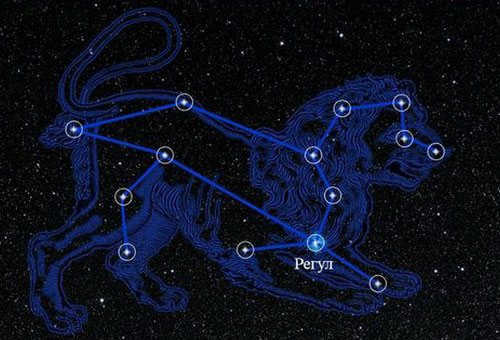
The outlines of a fearsome predator can be seen in the shape of the constellation.
If an individual is familiar with the location of the Big Dipper (also known as the Bucket), they can easily locate the Lion in the night sky. Simply envision tilting the Bucket towards the Lion, causing an imaginary stream of water to pour onto the neighboring animal’s head and mane. The stars in this part of the constellation create a reversed question mark shape, while others form the beast’s torso in the shape of a trapezoid.
Many individuals lack knowledge on how to locate the Leo constellation amidst the dark, starry sky. However, it is actually quite prominent and easily visible for most of the time. In various regions of the Russian Federation during the nighttime, a simple glance at a clear and cloudless sky will reveal the majestic lion within a matter of minutes.
Within the nocturnal heavens, the lion catches the eye due to its most brilliant star, Regulus, which is situated in close proximity to the ecliptic. By carefully observing the Leo constellation, one will notice that its brightest stars create a distinct trapezoid shape, serving as its defining characteristic.
You can spot the celestial predator and others by using other constellations. For instance, to the east of the celestial predator lies the constellation Virgo, whose star Spica is positioned very close to the ecliptic. When combined with Arthur, it forms an asterism known as the “spring triangle,” which can be easily observed even in unfavorable weather conditions.
Another easy-to-spot constellation is the Big Dipper, a beloved favorite among both adults and children. It is often the first constellation that star enthusiasts look for in the night sky. The Big Dipper is located to the north of Leo. It’s worth mentioning that the best time to observe this constellation is in February-March, and the Sun enters it in mid-August.
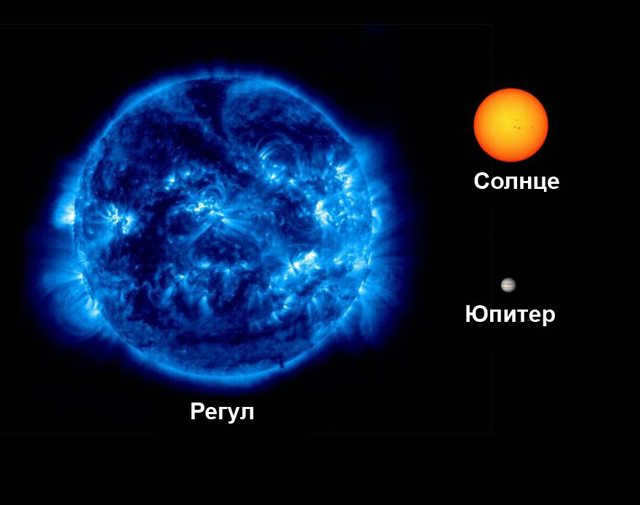
Comparing the star Regulus
The discovery and description of the constellation Leo
The constellation Leo is one of the oldest constellations in the northern hemisphere. It can be seen from all over Russia, but it is best observed from late March to May during the vernal equinox. Leo is the fifth constellation of the Zodiac, and it represents those who are born between July 22 and August 22.
The constellation Leo is easily identifiable in the night sky due to its resemblance to a lion. It is interesting to observe that throughout history, various cultures have given it similar names. For example, the Persian name for Leo is “Shir”, the Turkish name is “Artan”, the Syrian name is “Aguo”, the Jewish name is “Ague”, and in India, it is called “Simha” – all of these names translate to “Lion”.
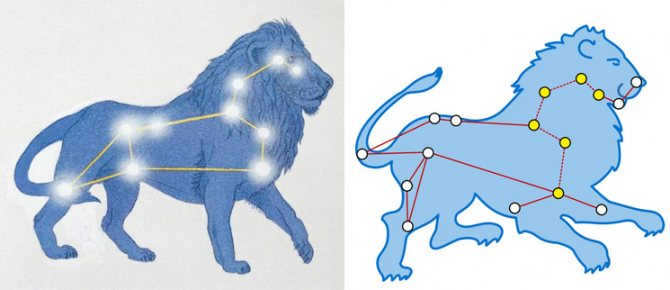
The constellation Leo is fascinating because of its striking resemblance to a lion. Alternatively, it was also perceived as a dog by the Assyrians.
In mythology, Leo symbolizes the Lion of Nemea, a beast slain by Hercules during his twelve labors. The Lion possessed a hide so impenetrable that it could not be pierced by iron, bronze, or stone. Hercules eventually located the Lion and strangled it to death using his bare hands, later elevating it to the heavens as a testament to his triumph.
Locating the constellation of Leo in the night sky is a simple task. During the spring months, it can be found positioned precisely between the constellations of Cancer to the west and Virgo to the east. Additionally, the "handle" of the Big Dipper can be used as a guide, as it points directly towards Leo like a compass arrow. A distinctive feature of Leo is the prominent "star sickle" that forms the "head" and "chest" of the lion.
The "sickle" is composed of several bright stars including Regulus, Algenubi, and Algieba, along with the dimmer stars ζ of Leo (Alhafera), μ of Leo (Ras Elazed Borealis), and ε of Leo (Ras Elazed Australis).
Why the constellation is named after the king of animals
The prominent stars form the shape of a reclining predator. According to historical records, the ancient Greeks were plagued by lion attacks, and one of Heracles’ earliest accomplishments was defeating this fearsome creature. Legend has it that Zeus, Heracles’ father, created the constellation Leo in the sky to commemorate this event.


Make an attempt to locate the constellation of Leo in the nighttime sky. Photograph: flickr.com/hubbleesa
The constellation of Leo becomes most apparent in the celestial sphere during the spring season, courtesy of its brilliant stars and the prominent shape that bears a resemblance to a lion. This particular constellation is of considerable size and holds the 12th rank in terms of its area.
This constellation, which is associated with the spring season, can be observed from February to March.
The Lion constellation is one of the oldest constellations and has been known since the times of the Sumerians, Ancient Egypt, and Greece. Hence, the origin of its name varies for each nation.
For instance, in ancient Egypt, this constellation rises almost to the zenith in March and April. During this time, a severe drought occurs, causing even the Nile Valley to dry up. Hungry lions then start wandering the desert in search of prey, and their roars can be heard throughout the neighborhood. This period, known as the time of the lions, coincides with the zenith of a specific constellation. That’s why it is called the Lion constellation. Interestingly, the main star of this constellation, Regulus, gets its name from the Latin word “king.” And it’s not without reason – according to belief, great kings are born under this constellation.
There is a different version of the name’s origin for the constellation that is more well-known. It relates to the Nemean Lion from Greek mythology, which was killed by Hercules during his quest to complete 12 renowned feats.
The Lion constellation in the sky
This constellation can be easily seen in the sky due to the bright star Regulus and the distinctive arrangement of stars that truly resembles a lion. In April, it is positioned high above the horizon, at the same level as the celestial equator, making it one of the zodiac constellations.
A more detailed star map of this constellation reveals numerous stars, with the most intriguing ones being discussed below.
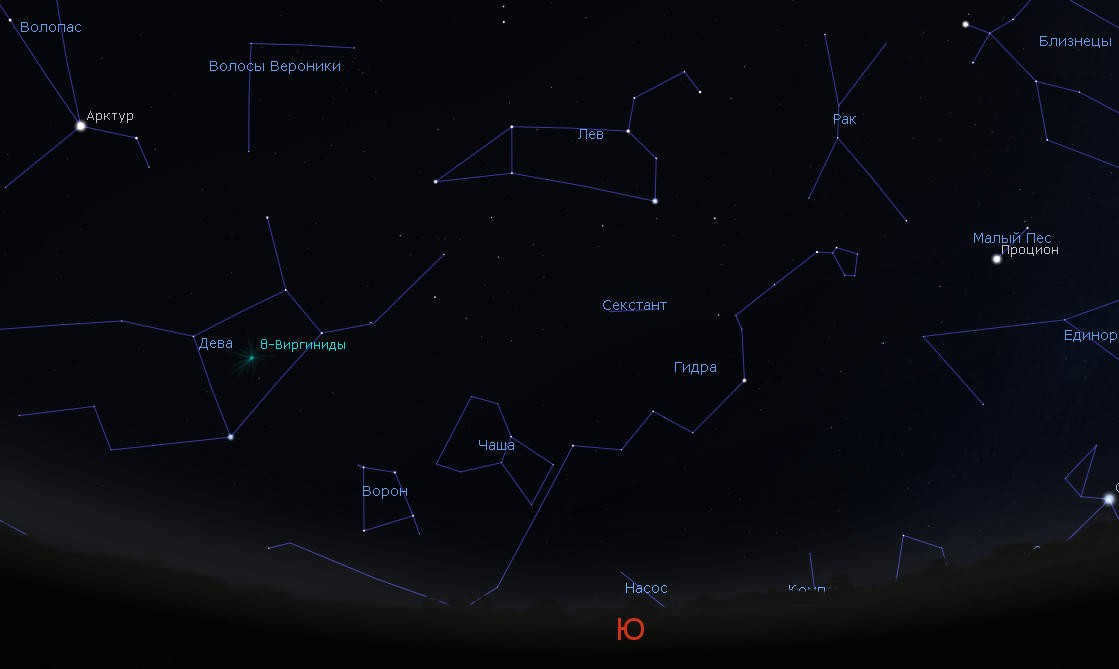
The unique stars of Leo’s constellation
Leo’s constellation is home to a multitude of stars, each possessing its own intriguing qualities, much like everything else that resides in the celestial realm. The constellation itself is an exquisite sight to behold, and if you employ the aid of binoculars, you will be able to witness an incredible array of diverse stars.
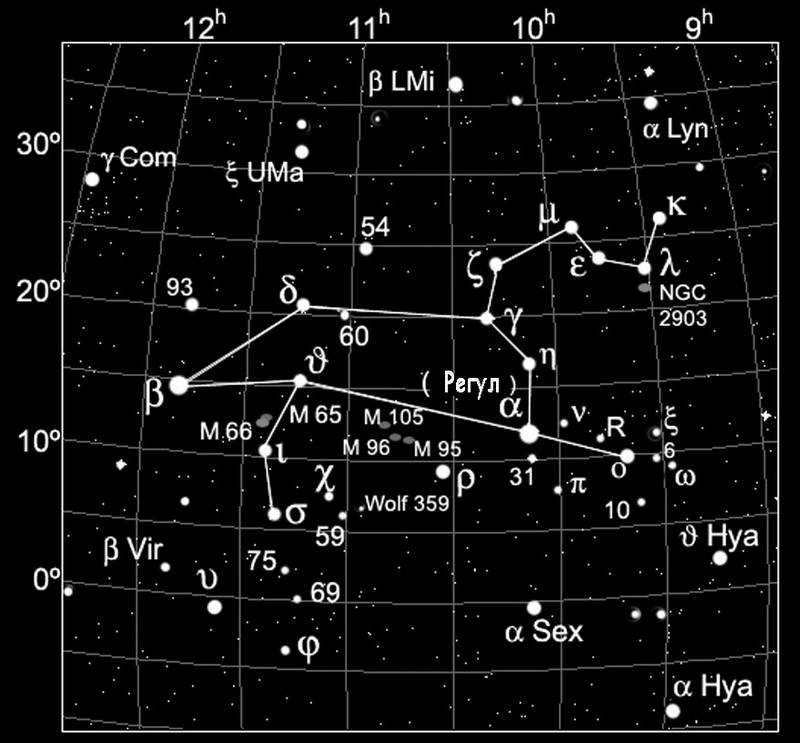
Regulus
Regulus is the primary star of the Leo constellation, known as its alpha, and has a magnitude of 1.36. Its name, derived from Latin, means “king” or “prince”. The Arabic name for Regulus, Kalb al-Asad, translates to “heart of the lion”.
Regulus is a relatively young star, with an estimated age of a few million years. It is located approximately 77.5 light years away from Earth, which contributes to its notable brightness. Among the top 20 brightest stars, Regulus holds the 20th position.
Regulus A, weighing 3.5 times the mass of the Sun, exhibits rapid rotation, completing one revolution in a mere 16 hours. Consequently, the star’s shape is highly flattened, resulting in its polar regions being 50% hotter than its equatorial regions. Our perspective of this star is from the edge, meaning it is oriented towards us with its equator. Accompanying this luminous star is a smaller, dimmer companion, and together they orbit a shared center of gravity.
If Regulus A were to spin even slightly faster, its gravitational force would be insufficient, leading to its disintegration.
Regulus is, in fact, a complex star system. The primary system consists of two prominent stars, which are further accompanied by another pair of companions that form their own binary system. This entire arrangement revolves around a central point of gravity over a period of 130,000 years.
Denebola
Denebola, situated in the Leo constellation, is the second most luminous star and holds the position of beta. With a magnitude of 2.14m, it radiates 12 times more light than our very own Sun. This particular star is located 36 light years away.
Despite its distance, Denebola remains in its youthful stage, estimated to be a mere 400 million years old. It surpasses the Sun in size by 1.73 times and is 75% more massive, boasting a surface temperature nearly twice as hot. In terms of rotation, Denebola spins at a staggering 60 times the speed of the Sun.
Extensive research has uncovered the presence of a cold matter disk surrounding Denebola, comprised of dust, gas, and various debris. It is highly plausible that exoplanets exist within this system. Given the star’s relatively young age, the process of planet formation is likely still ongoing.
Denebola is classified as a δ Shield type variable star, with its brightness fluctuating by 0.025m over a span of 2-3 hours.
Algeiba
Algeiba, also known as Algieba, is one of the most luminous stars in the Leo constellation, labeled as γ – gamma. It is located approximately 130 light years away.
Algeiba is classified as a binary star, consisting of a pair of giant stars that are 10 and 23 times larger than the Sun, respectively. Although their mass is similar to that of the Sun, these stars are significantly older, having a age of around 2 billion years. As a result of nuclear reactions, they have gone through a process of expansion after burning their hydrogen fuel.
In 2009, astronomers detected an exoplanet near one of the stars in the Algeiba system. This exoplanet has a mass approximately 8 times greater than Jupiter. There is a possibility that there may be another exoplanet in the system, but further confirmation is needed to verify its existence.
Wolf 359
Wolf 359 is a rather ordinary red dwarf star that can only be observed using a relatively powerful telescope, as its brightness is just 13.53m. However, it is significant because it is one of our closest celestial neighbors, located only 7.8 light-years away. There are only a handful of stars that are even closer, such as Alpha Centauri.
This particular star is quite small, with a mass ranging from 0.09 to 0.13 times that of the Sun, and its radius is less than 0.2 times the radius of our own star.
Kaffau star
The star known as SDSS J102915+172927, also referred to as the “impossible star,” is composed primarily of hydrogen and helium, making up 99.9% of its composition. The presence of other elements in the star is minimal, which defies theoretical expectations. In comparison, the Sun has a metallicity, or the abundance of elements heavier than helium, that is approximately 20 thousand times greater than that of the Kaffau star.
Asterisms in Leo’s Constellation
An asterism is a distinctive line or shape created by bright stars. Within the constellation of Leo, there is an asterism known as the Sickle. This formation consists of the stars α, η, γ, ζ, μ, and ε, and remarkably resembles the shape of a sickle.

Why is the Leo constellation called the Asterism Sickle?
When it comes to the Leo constellation, it is known for its collection of galaxies. However, there are no exceptionally bright galaxies in this constellation. To observe them, you will need a powerful telescope with an aperture of at least 150 mm, or preferably 200 mm or more. While it is possible to detect them with a weaker instrument, these parameters will allow you to fully appreciate their shape and even capture them in photographs.
Now, let’s take a closer look at some of the most fascinating and luminous galaxies in the Leo constellation. To locate them in the night sky, you can utilize the free planetarium software called “Stellarium,” which is also available as a smartphone app.
Galaxy M 65
can be rephrased as
65 Galaxy M
or
M 65 Galaxy
.
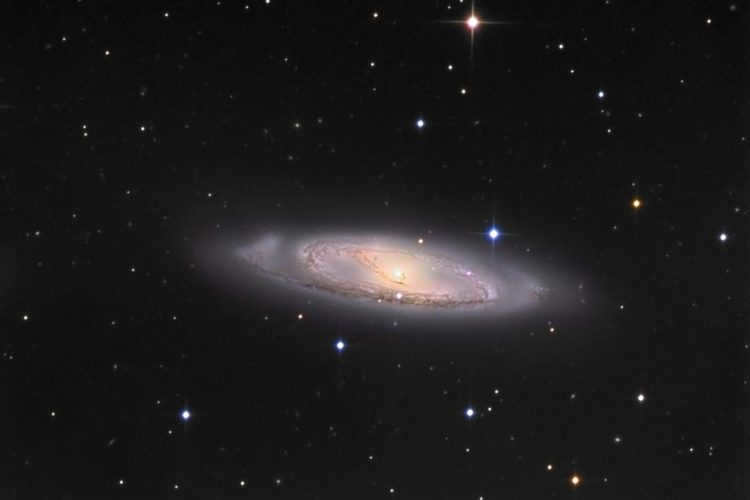
This particular spiral galaxy, which can be observed at a significant angle, is also known as NGC 3628. It is a member of a trio of galaxies referred to as the Leo Triplet, and when viewed through a telescope, it can be quite challenging to distinguish them from one another. The estimated distance to this group of galaxies is approximately 35 million light years.
Galaxy M 65 possesses a magnitude of brightness of 9.3m, but its surface brightness measures at 12.7m. As a result, a telescope with an aperture of 200mm or greater is necessary to perceive its central region and overall structure. The spiral arms become visible when observed through a telescope with a diameter of 300mm.
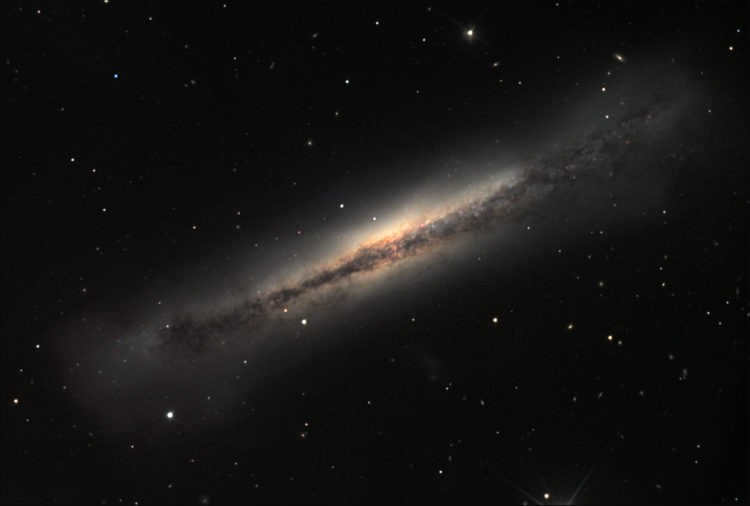
NGC 3627, also known as Galaxy M 66, is a spiral galaxy that can be seen from the periphery. The prominent dust clouds within its disk are easily visible due to its position. Its shape is highly elongated and flattened, a result of the gravitational influence exerted by other galaxies in the Leo Triplet. Consequently, it is classified as a peculiar galaxy. With a size of 100,000 light years and a distance of 35 million light years, NGC 3627 is quite remarkable.
Notably, this galaxy has a brightness of 8.9m and a surface brightness of 12.7m. Given these characteristics, observing NGC 3627 necessitates the use of a relatively powerful telescope.
Galaxy M 95
Rewrite the text to make it unique, using the English language and preserving the HTML markup:
Galaxy M 95

This particular galaxy is quite remarkable as it presents itself in a flat orientation. Pierre Meschen discovered it in 1781, and it was promptly included in Messier’s collection.
With a luminosity of 9.8m and located 40 million light years away, this galaxy demands the use of a high-quality telescope for proper observation, despite its striking appearance in the photograph.
Galaxy M 96: A Stellar Smartphone

The appearance of this galaxy is incredibly impressive and has a somewhat ethereal quality to it. Pierre Mechene was the one to first discover it in 1781, making it one of the pioneer spiral galaxies found. With a brightness of 9.2m and an angular size of 7.8′ × 5.2′, it stands out among the stars.
The Spectacular NGC 2903 Galaxy






